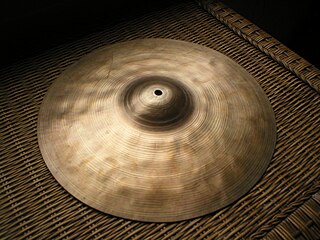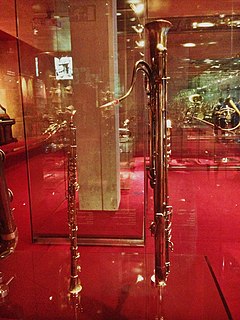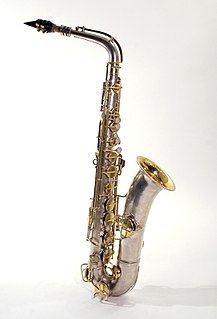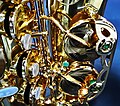
A cymbal is a common percussion instrument. Often used in pairs, cymbals consist of thin, normally round plates of various alloys. The majority of cymbals are of indefinite pitch, although small disc-shaped cymbals based on ancient designs sound a definite note. Cymbals are used in many ensembles ranging from the orchestra, percussion ensembles, jazz bands, heavy metal bands, and marching groups. Drum kits usually incorporate at least a crash, ride, or crash/ride, and a pair of hi-hat cymbals. A player of cymbals is known as a cymbalist.

The clarinet is a type of single-reed woodwind instrument. Like many wind instruments, clarinets are made in several different sizes, each having its own range of pitches. All have a nearly-cylindrical bore and a flared bell, and utilize a mouthpiece with a single reed. A person who plays a clarinet is called a clarinetist.

The saxophone is a type of single-reed woodwind instrument with a conical body, usually made of brass. As with all single-reed instruments, sound is produced when a reed on a mouthpiece vibrates to produce a sound wave inside the instrument's body. The pitch is controlled by opening and closing holes in the body to change the effective length of the tube. The holes are closed by leather pads attached to keys operated by the player. Saxophones are made in various sizes and are almost always treated as transposing instruments. Saxophone players are called saxophonists.

The trombone is a musical instrument in the brass family. As with all brass instruments, sound is produced when the player's vibrating lips (embouchure) cause the air column inside the instrument to vibrate. Most brass instruments use valves to alter the pitch, but trombones have a telescoping slide mechanism instead. Many modern trombone models also have a valve attachment which lowers the pitch of the instrument. Variants such as the valve trombone and superbone have three valves similar to those on the trumpet.

The sousaphone is a brass instrument in the tuba family. Created around 1893 by J. W. Pepper at the direction of American bandleader John Philip Sousa, it was designed to be easier to play than the concert tuba while standing or marching, as well as to carry the sound of the instrument above the heads of the band. Like the tuba, sound is produced by moving air past the lips, causing them to vibrate or "buzz" into a large cupped mouthpiece. Unlike the tuba, the instrument is bent in a circle to fit around the body of the musician; it ends in a large, flaring bell that is pointed forward, projecting the sound ahead of the player. Because of the ease of carrying and the direction of sound, it is widely employed in marching bands, as well as various other musical genres. Sousaphones were originally made of brass. Beginning in the mid-20th century, some sousaphones have also been made of lighter materials such as fiberbrass & plastic.

The sarrusophones are a family of transposing woodwind musical instruments patented and placed into production by Pierre-Louis Gautrot in 1856. Originally designed as double-reed instruments, sarrusophones were later developed that used single-reed mouthpieces, at least for some of the larger sizes. It was named after the French bandmaster Pierre-Auguste Sarrus (1813–1876), who is credited with the concept of the instrument, though it is not clear whether Sarrus benefited financially from this association. The instrument was intended to serve as a replacement in wind bands for the oboe and bassoon, which, at that time, lacked the carrying power required for outdoor band music.

A mute is a device attached to a musical instrument which changes the instrument's tone quality (timbre) or lowers its volume. Mutes are commonly used on string and brass instruments, especially the trumpet and trombone, and are occasionally used on woodwinds. Their effect is mostly intended for artistic use, but they can also allow players to practice discreetly. Muting can also be done by hand, as in the case of palm muting a guitar or grasping a triangle to dampen its sound.

The mellophone is a brass instrument typically pitched in the key of F, though models in B♭, E♭, C, and G have also historically existed. It has a conical bore, like that of the euphonium and flugelhorn. The mellophone is used as the middle-voiced brass instrument in marching bands and drum and bugle corps in place of French horns, and can also be used to play French horn parts in concert bands and orchestras.

An electric piano is a musical instrument which produces sounds when a performer presses the keys of a piano-style musical keyboard. Pressing keys causes mechanical hammers to strike metal strings, metal reeds or wire tines, leading to vibrations which are converted into electrical signals by magnetic pickups, which are then connected to an instrument amplifier and loudspeaker to make a sound loud enough for the performer and audience to hear. Unlike a synthesizer, the electric piano is not an electronic instrument. Instead, it is an electro-mechanical instrument. Some early electric pianos used lengths of wire to produce the tone, like a traditional piano. Smaller electric pianos used short slivers of steel to produce the tone. The earliest electric pianos were invented in the late 1920s; the 1929 Neo-Bechstein electric grand piano was among the first. Probably the earliest stringless model was Lloyd Loar's Vivi-Tone Clavier. A few other noteworthy producers of electric pianos include Baldwin Piano and Organ Company and the Wurlitzer Company.

The tenor saxophone is a medium-sized member of the saxophone family, a group of instruments invented by Adolphe Sax in the 1840s. The tenor and the alto are the two most commonly used saxophones. The tenor is pitched in the key of B♭ (while the alto is pitched in the key of E♭), and written as a transposing instrument in the treble clef, sounding an octave and a major second lower than the written pitch. Modern tenor saxophones which have a high F♯ key have a range from A♭2 to E5 (concert) and are therefore pitched one octave below the soprano saxophone. People who play the tenor saxophone are known as "tenor saxophonists", "tenor sax players", or "saxophonists".

The baritone saxophone is a member of the saxophone family of instruments, larger than the tenor saxophone, but smaller than the bass. It is the lowest-pitched saxophone in common use - the bass, contrabass and subcontrabass saxophones are relatively uncommon. Like all saxophones, it is a single-reed instrument. It is commonly used in concert bands, chamber music, military bands, big bands, and jazz combos. It can also be found in other ensembles such as rock bands and marching bands. Modern baritone saxophones are pitched in E♭.

The soprano saxophone is a higher-register variety of the saxophone, a woodwind instrument invented in the 1840s. The soprano is the third-smallest member of the saxophone family, which consists of the soprillo, sopranino, soprano, alto, tenor, baritone, bass, contrabass saxophone and tubax. Soprano saxophones are the smallest and thus highest-pitched saxophone in common use.
C.G. Conn Ltd., sometimes called Conn Instruments or commonly just Conn, is a former American manufacturer of musical instruments incorporated in 1915. It bought the production facilities owned by Charles Gerard Conn, a major figure in early manufacture of brasswinds and saxophones in the USA. Its early business was based primarily on brass instruments, which were manufactured in Elkhart, Indiana. During the 1950s the bulk of its sales revenue shifted to electric organs. In 1969 the company was sold in bankruptcy to the Crowell-Collier-MacMillan publishing company. Conn was divested of its Elkhart production facilities in 1970, leaving remaining production in satellite facilities and contractor sources.

The C melody saxophone is a saxophone pitched in the key of C, one whole tone above the B-flat tenor saxophone. In the UK it is sometimes referred to as a "C tenor", and in France as a "tenor en ut". The C melody was part of the series of saxophones pitched in C and F intended by the instrument's inventor, Adolphe Sax, for orchestral use. The instrument enjoyed popularity in the early 1900s, perhaps most prominently used by Rudy Wiedoeft and Frankie Trumbauer, but is now uncommon.
The Buescher Band Instrument Company was a manufacturer of musical instruments in Elkhart, Indiana, from 1894 to 1963. The company was acquired by the H&A Selmer Company in 1963. Selmer retired the Buescher brand in 1983.

The Julius Keilwerth company is a German saxophone manufacturer, established in 1925.
Jupiter Band Instruments, Inc. is a manufacturer and distributor of woodwind, brass and percussion instruments. Jupiter was established by its Taiwanese parent company KHS in 1980.

Nauheim is a municipality in Groß-Gerau district in Hesse, Germany. Nauheim is located southwest of Frankfurt am Main and is part of the metropolitan region of Frankfurt. It lies in the Hessian Ried.

King Musical Instruments is a former musical instrument manufacturing company located in Cleveland, Ohio, that used the trade name King for its instruments. In 1965 the company was acquired by the Seeburg Corporation of Eastlake, Ohio, and the name changed to "King Musical Instruments".
Herbert Couf was an American clarinetist, saxophonist, composer, music store owner, music instrument manufacturer executive, and an importer of music instruments. Couf had been the principal clarinetist with the Detroit Symphony Orchestra under Paul Paray until he retired to open Royal Music Center and commit his full attention to the business of music.




















